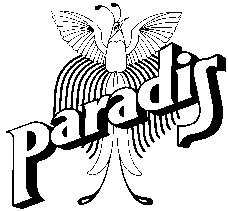this is the original publication about the Paradis technology. In 2004, Rolf Spuler did the next step for it.

|
|
this is the original publication about the Paradis technology. In 2004, Rolf Spuler did the next step for it.

|
|
Fundamental to the PARADIS concept is
the electronically individual treatment of each string.
All guitars are mounted with six
perfectly separated high quality pickups.
Up to now, hexaphonic pickups were
mostly used to control guitar synthesizer systems. - ours do that
too. But it is sad to hear the artist´s subtle playing reduced
to the MIDI information "pitch" and "attack". The aim is rather to
form rich, broad, and dynamic sounds from the inspired original
vibrations of the string. Therefore, the individual treatment
of the strings is basic. Hexaphonic effects or a mixing desk will be
your working field.
In magnetic pickups, it is on
principle not possible to combine high string separation with full
sound. Therefore, most hexaphonic pickups are built just to control
synthesizers while their sound is not suitable for
amplification.
PARADIS developed a bridge piezo pickup
without loss to reproduce all strings identically and perfectly
separated. Also, neither electromagnetic nor electrostatic fields can
interfere. The sound is uncoloured (we leave this to wood and
electronic effects), but reproduces the exact vibration of the
string. The PARADIS polyphonic piezo pickup does not need a guitar
amplifier and sounds best on a linear sound system.

POLYSUBBASS is a versatile extension
for the PARADIS hexaphonic guitars. It is capable to lower the lowest
picked string by one octave and add it to the original sound. Softly
added, the result is an amazing full bass sound. Used more strongly
it can give the impression of an accompanying bass player.
Furthermore, the machine provides the necessary 10 outputs to treat
each string and it mixes to mono or stereo for amplification on a
hi-fi or PA system.
The lower three strings are divided
by three special versions of the known octave effect. Since they are
adapted for this purpose and tuned to the strings, they work very
softly and produce no errors. Contrary to a MIDIed bass sound, this
effect oscillates synchronously with the string and therefore joins
it like a natural part of the vibration. The bass signal is slightly
limited to avoid overloading of the equipment and to preserve the
natural attack of the instrument. Towards the higher notes of the
bass strings the effect smoothly fades.
In the regular mode, all three strings
are oktaved at the same time, which produces a particularly heavy
bass sound for straight chords. But in general, the mixture of low
bass notes produce disliked intermodulation. Therefore we have
developed the Priority circuit (pat. pend.) that selects the lowest
of the played strings and does not octave the others. In this
priority mode, always a single clean bass line appears - a feature
that MIDI does not offer so far.
The volume of the effect can be
controlled on the front. It can either be mixed to the mono and
stereo outputs or wired separately to a channel on the mixer. To
bypass the effect, there is a switch on the front and a jack on the
back that accepts a common on/off foot switch.
On six jacks on the back , you have access to each string. They give you unlimited creativity. On a mixer, they can be equalized and panned individually and put through different effects. The dream might be a MIDIed multi-effect for each string. Playing noises can be filtered effectively with a noise gate on each string. If you provide six channels on the multi-track machine, you can even edit unwanted notes from single chords.
In most cases the individual treatment of the strings is unnecessary or too complex. Therefore a mono and a stereo output is provided. Stereo can be wired with two monojacks or one stereo jack (which can serve as a headphones output too). The stereo effect is produced by the following distribution of the strings in space:
This is just one good possibility out
of an infinite number. If you find a different personal preference,
it can be realized in your machine by changing plugged resistors. We
gladly advise you.
Only hexaphonic guitar signals can be
converted to MIDI. The various Producers of such systems all use
different wiring. Most guitar-to-MIDI converters can be connected to
the hexaphonic output on the back. We offer the cable
to the ROLAND GR-system.
More about Guitar to
MIDI
To avoid losses on the cables, high class guitars use a preamplifier in the instrument. But the checking and changing of the battery is a headache for most musicians. Also, the best noiseless chips cannot be used because they draw to much current from the battery. In our system the six high quality preamps in the guitar are fed through a separate wire in the cable, - you note the higher dynamic !
read about and listen to POLYDISTORTION, another effect created for this system